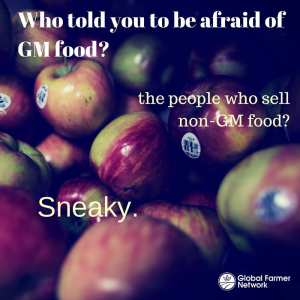Recently, I got a pretty awesome notification from Facebook — they now allow you to report fake news. Fake news has been a very big problem online in all facets of life, but just how can we tell if a source is credible? Here are a few tips:
- Is the website trying to sell you something? Be wary if they’re evoking fear of a competitor to sell a product or ideology.
- What is the author’s background? Is an author even listed? Check the “about” section.
- Is it overdramatized sensationalism? If it sounds too catchy or shocking, it probably is.
- Are there a lot of “shocking” side links that are looking for clicks (i.e. “Clickbait”)?
- Extraordinary claims require extraordinary evidence. Are there peer reviewed links?
- Is the website asking for donations? Do they have an agenda?
When in doubt, explore the other side of the issue and track down a real industry expert who devotes their entire life and career to the topic at hand. Sometimes a website can be reputable in one area but completely irresponsible in another. The New York times is a good example of this. They may be reputable for current events or local news, but they have received much scrutiny for their sloppy articles on agriculture written by Danny Hakim. Mr. Hakim has been absolutely slaughtered on Twitter.

Speaking of slaughter, have you heard ungodly awful stories about animal agriculture? Examine the source. HSUS, or the Humane Society of the United States, has lobbied over $172 million against animal agriculture last year alone while only donating 1 percent of “charitable” contributions to helping dogs and cats. They are essentially PETA in a business suit and have been caught lying on numerous occasions. Mercy for animals and other “Go Vegan” front groups have an agenda. They want to make animals looks like they’re always raised in horrific conditions as they want people to give up meat, milk, and eggs in general while asking for donations. They’ve even been caught staging fake videos, lying, and stealing. Sure, it is perfectly fine if someone decides to not eat meat, and many people who choose this route are good people with good intentions. It’s perfectly okay to expose animal cruelty, we can all agree on that. But it’s not OK to paint an entire industry with a broad negative brush when the reality is that actual animal cruelty only occurs on less than 1 percent of farms. Ask any farmer, we will almost always put an animal’s needs before our own. It’s our passion and livelihood.
While many anti-meat activists are horribly misinformed, the anti-GMO crowd is usually the same. Occasionally when I speak out about being pro-GMO I am called a shill. I’m not, but who are the actual shills? As I’ve outlined previously here, the organic industry spends nearly $3 billion a year leading with fear against conventional agriculture to push sales of their products. Over 95 percent of certain crop farmers are growing GMOs for good reasons, which substantially help the environment. So who’s saying they’re bad? The huge food corporations that want to sell organic foods made in China and charge a premium? Websites trying to sell you their “non-GMO” alternative product? Well of course GMOs are magically bad according to them — they’re selling a competitive product … sneaky.

Generally speaking, someone in a big city who identifies as vegan or a marketing executive from a huge food corporation in a place like downtown New York City is going to be a lot less knowledgable about agriculture than a real boots-on-the-ground farmer. If a farmer in a place like rural Kansas works the soil and the animals as a career, all day, everyday with decades of experience and knowledge, this is a very good source. Common sense.
To connect with real industry experts and see the most reputable sources out there, click this link which includes my top 100 sources for truth in agriculture. In terms of identifying fake news, below is what I like to call the “Facepalm Hall of Fame,” or the worst culprits of fake news on the internet. These are the pages that don’t speak the truth and don’t deserve our likes and shares. They may be funded by misinformed activists, they may be full of crazy conspiracy theories, they may just be spreading point blank lies. These sites all have one thing in common though — almost all of them share misinformed opinions of agriculture but have never actually worked in agriculture a day in their lives. I would trust someone who has grown 1,000 acres of canola before trusting a big-city activist with a computer science degree, wouldn’t you? Friends don’t let friends share pseudoscience. Here are the worst sites on the internet about agriculture in no particular order:
Real Farmacy
Food Babe
EcoWatch
Environmental Working Group
Pesticide Action Network
The Non-GMO Project
GMO Free USA
Mamavation
Nutiva
Natural News
Mercola
David “Avocado” Wolfe
GMO Inside
PETA
Pete Evans
Green Med Info
Food Democracy Now
Kids Right to Know
Food & Water Watch
Robyn O’Brien
Just Label It
US Right to Know
Dr. Oz
Consumer Reports
Only Organic
Organic Consumers Association
Cornucopia Institute
Vandana Shiva
Moms Across America
Erin @ Health Nut News
Mercy for Animals
HSUS
Best Video You Will Ever See
Erin Janus
Healthy Holistic Living
Commondreams
Collective Evolution
The Mind Unleashed
March Against Monsanto

When reading anything off of these sites, take the information presented with a grain of salt. Look at their background, funding, sensationalism and lies. Check out the authors and see if they’ve ever actually been to a real large scale farm! Click here for more information on how you can discover, avoid, and report fake news.
Michelle Miller, the Farm Babe, is an Iowa-based farmer, public speaker and writer, who lives and works with her boyfriend on their farm which consists of row crops, beef cattle, and sheep. She believes education is key in bridging the gap between farmers and consumers.



